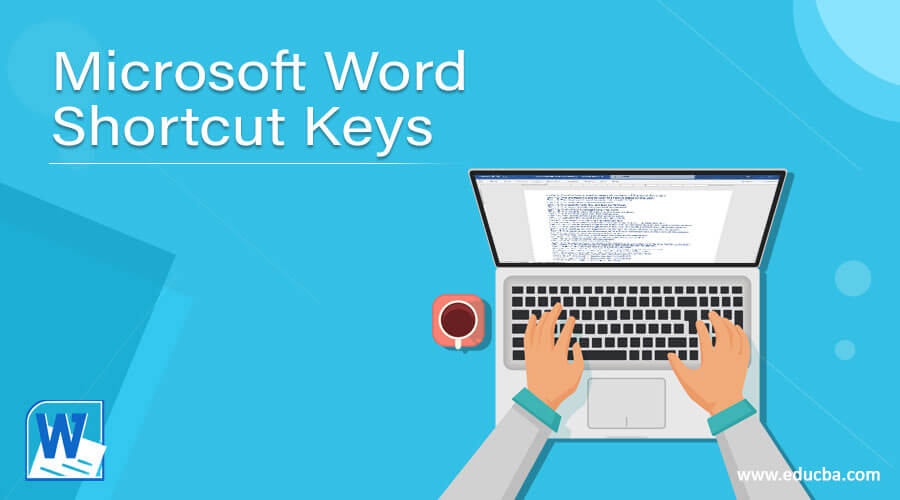Introduction to Microsoft Word Shortcut Keys
The following article provides an outline for Microsoft Word Shortcut Keys. Microsoft word is a word processor developed by Microsoft company. Microsoft word provides various functions ranges from basic to advanced to make the work easy and makes the document attractive and effective. There are some shortcuts key that will help you carry out the same function easily and save your time.
For example, if you want to copy the whole document, you need to select the content with a mouse’s help and need to click on the copy option, which is present in the home tab. Instead of doing these all steps, you can just click ctrl + A to select the whole content and ctrl + C to copy the same.
Different Microsoft Word Shortcut Keys
Given below are the different Microsoft word shortcut keys:
- Ctrl + A: This shortcut is used to select all contents of the word document.
- Ctrl + C: This shortcut is used to copy the text selected by the user.
- Ctrl + V: This shortcut is used to paste the copied text.
- Ctrl + X: It is used to cut the selected text.
- Ctrl + Y: It is used to redo the last task performed.
- Ctrl + Z: It is used to undo the last task performed.
- Ctrl + B: Highlight the selected text in bold.
- Ctrl + D: It is used to open the font preference window.
- Ctrl + F: It is used to open the find dialog box.
- Ctrl + P: This shortcut key opens the print window.
- Ctrl + I: Highlight the selected text in italic form.
- Ctrl + U: It is used to underline the selected text.
- Ctrl + Shift + D: It is used to highlight double underline for the selected text.
- Ctrl + E: It is used to set the alignment of the line or selected text to the center of the screen.
- Ctrl + L: It is used to set the alignment of the line or selected text to the left of the screen.
- Ctrl + J: It is used to set the alignment of the line or selected text to justify the screen.
- Ctrl + R: It is used to set the alignment of the line or selected text to the right of the screen.
- Ctrl + K: It is used to add a hyperlink to the text.
- Ctrl + N: This shortcut key is used to open the new blank document.
- Ctrl + W: It is used to close the currently open word document.
- Ctrl + M: It is used to indent the paragraph.
- Ctrl + S: It is used to save the document.
- Ctrl + O: It is used to open the dialog box, where the user can select the file that needs to be open.
- Ctrl + Shift + A: It is used to set all the selected text letters to capital.
- Ctrl + Shift + L: It is used to add a bullet point to the text.
- Ctrl + Home: It is used to move the cursor at the beginning of the document.
- Ctrl + End: It is used to move the cursor at the end of the document.
- Ctrl + Spacebar: It is used to set the selected text to the default font.
- Ctrl + Alt + 1: It is used to change the text to heading 1.
- Ctrl + Alt + 2: It is used to change the text to heading 2.
- Ctrl + Alt + 3: It is used to change the text to heading 3.
- Shift + Alt + T: It is used to add the current time.
- Shift + Alt + D: It is used to add the current date.
- F12: It is used to prompt the save as a window.
- F1: This shortcut key will open the help window.
- F7: It is used to open the Spellcheck and grammar check window.
- F5: It is used to open the find, replace, and go to the window.
- F4: It is used to repeat the last performed action.
- Ctrl + Left Arrow: It is used to move the one word to the left.
- Ctrl + Right Arrow: It is used to move the one word to the right.
- Ctrl + Up Arrow: It is used to move to the start of the line or paragraph.
- Ctrl + Down Arrow: It is used to move to the end of the line or paragraph.
- Ctrl + Del: It is used to delete the word to the right of the cursor.
- Ctrl + Backspace: It is used to delete the word to the left of the cursor.
- Ctrl + Shift+ <: It is used to decrease the size of the font by one point.
- Ctrl + Shift+ >: It is used to increase the size of the font by one point.
- Ctrl + Shift+ *: It is used to hide or view the non-printing characters.
- Ctrl + T: It is used to create a hanging indent.
Conclusion
Instead of performing the number of steps, Microsoft word shortcut keys help users to carried out the task by clicking two-three buttons on the keyboard and saves them time and makes the task easier.
Recommended Articles
This is a guide to Microsoft Word Shortcut Keys. Here we discuss the introduction and different Microsoft word shortcut keys, respectively. You may also have a look at the following articles to learn more –


